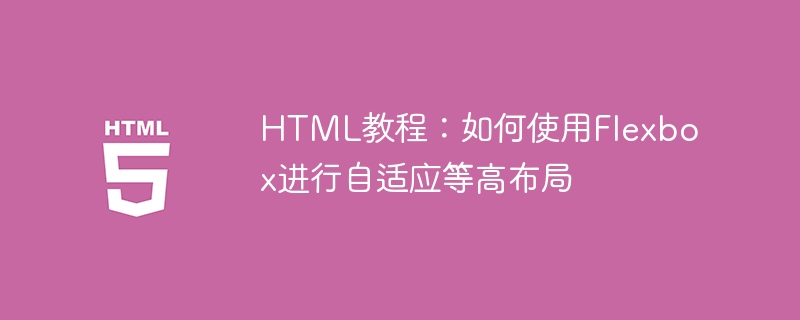Home >Web Front-end >HTML Tutorial >HTML tutorial: How to use Flexbox for adaptive equal height layout
HTML tutorial: How to use Flexbox for adaptive equal height layout
- PHPzOriginal
- 2023-10-21 10:00:511145browse

HTML tutorial: How to use Flexbox for adaptive equal-height layout, specific code examples are required
Introduction:
In web design and development, realize adaptive Contour layout is a common requirement. Traditional CSS layout methods often face some difficulties when dealing with equal height layout, and Flexbox layout provides us with a simple and powerful solution. This article will introduce the basic concepts and common usage of Flexbox layout, and give specific code examples to help readers quickly master the skills of using Flexbox to implement adaptive equal-height layout.
1. Introduction to Flexbox Layout
Flexbox layout (flexible box layout) is a new layout model introduced in CSS3, aiming to solve many pain points and limitations of traditional layout methods. It provides a flexible and powerful set of properties that allow elements to easily adapt to different screen sizes and devices. Flexbox layout implements layout by arranging containers and inner items along main and cross axes.
2. Basic concepts of Flexbox layout
1. Container: Elements that use the display attribute set to flex or inline-flex are called Flex containers.
2. Items: Each sub-element within the container is an item, called a Flex item.
3. Main Axis: A straight line of the Flex project on the container, which defaults to the horizontal direction.
4. Cross Axis: Another axis perpendicular to the main axis.
3. Common uses of Flexbox layout
1. Implement adaptive equal height layout
Adaptive equal height layout means that no matter how much content one item has, the height of other items will be the same as the height of the other items. The highest items are consistent. This effect can be easily achieved using Flexbox layout, just set the container's flex-direction property to column and add the flex property to all items. The specific code examples are as follows:
<div class="container"> <div class="item">项目1</div> <div class="item">项目2</div> <div class="item">项目3</div> </div>
.container {
display: flex;
flex-direction: column;
}
.item {
flex: 1;
}2. Achieve horizontal or vertical centering
Using Flexbox layout, you can easily achieve horizontal or vertical centering effects. You can achieve horizontal centering by setting the align-items property of the container, or vertical centering by setting the justify-content property. The specific code examples are as follows:
<div class="container"> <div class="item">项目1</div> <div class="item">项目2</div> <div class="item">项目3</div> </div>
.container {
display: flex;
align-items: center; /* 水平居中 */
justify-content: center; /* 垂直居中 */
}
.item {
width: 200px;
height: 100px;
}3. Implement a mixed layout of fixed width and adaptive width
Using Flexbox layout, you can easily implement a mixed layout of fixed width and adaptive width. Fixed-width items can be set to have a fixed-width value, and adaptive-width items can be set to flex. Specific code examples are as follows:
<div class="container"> <div class="item fixed-width">固定宽度</div> <div class="item">自适应宽度</div> <div class="item">自适应宽度</div> </div>
.container {
display: flex;
}
.item {
flex: 1;
}
.fixed-width {
width: 200px;
} 4. Summary
Flexbox layout is a powerful and flexible layout model that provides a solution to traditional CSS layout problems. This article introduces the basic concepts and common usage of Flexbox layout, and gives specific code examples to help readers quickly get started and master the skills of using Flexbox to implement adaptive equal-height layout. I hope this article can be helpful to readers when implementing adaptive layout in web design and development.
The above is the detailed content of HTML tutorial: How to use Flexbox for adaptive equal height layout. For more information, please follow other related articles on the PHP Chinese website!

